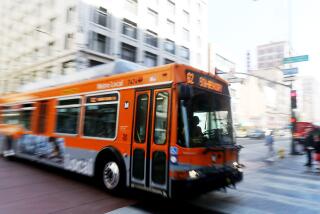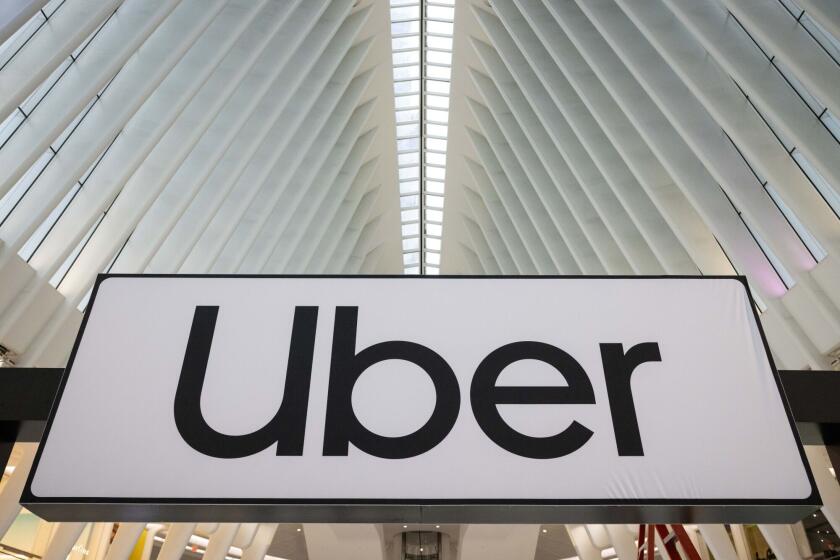MID-WILSHIRE : Vigil Is Not Over for MTA Watchdogs
- Share via
The city’s 350,000 daily bus riders have been spending a little more on fares over the past few weeks, but local activists have nevertheless found reason to celebrate.
Were it not for a lawsuit filed by the Labor/Community Strategy Center and its offshoot, the 500-member Bus Riders Union, fares would have gone from $1.10 to $1.35 much sooner, and there would no longer be any adult discount passes.
“A $49 pass is better than no pass at all,” said Martin Hernandez, an organizer for the Strategy Center. “So we see it as a victory.”
The issue of affordable, user-friendly public transportation has been on the 5-year-old group’s front burner for some time. When the Metropolitan Transportation Authority began moving toward bus fare increases early last year, they began sending representatives to public hearings, while passing out close to 25,000 flyers decrying the increases and canvassing buses for supportive riders.
Shortly after the MTA’s July vote to raise rates and eliminate the $42 monthly pass--to offset a $126-million funding deficit--the Bus Riders Union was born, and has been growing since.
“We’re learning how to build a constituency out of those 350,000 people who ride the bus every day,” said Strategy Center Director Eric Mann. “We think that if they can be turned into a powerful constituency, they can turn public transportation on its head.”
The Strategy Center and the Bus Riders Union--along with the Korean Immigrant Workers’ Advocates and the Southern Christian Leadership Conference--filed a suit against the MTA on Aug. 31, 1994, the day before the changes were to take effect. By raising bus fares while continuing to spend on rail projects, the plaintiffs alleged, the MTA was unwittingly discriminating against their most regular customers: the urban poor who cannot afford cars.
The day after they filed their suit, U.S. District Judge Terry Hatter issued a temporary order blocking the fare changes, finally lifting it last month under the condition that the bus passes stay, although they could be raised to $60.
A compromise the plaintiffs negotiated with the MTA led to the new fare structure adopted Feb. 1.
The Labor/Community Strategy Center, at 3780 Wilshire Blvd., began in 1989 to lobby civic and corporate leaders with a platform that Mann described as “environmentalism meets social justice.” The center organized residents of industrial zones such as Wilmington to push refineries and other industries for reduced emissions. The center also campaigned against Proposition 187.
“We see ourselves as a sophisticated grass-roots organization,” said Mann, whose group is funded by foundation grants and member dues. “Our long-term goal is not to develop a group of angry bus riders, but a group of riders who can change public policy and see themselves as a major political bloc in this city.”
Said Constance Rice, an attorney with the NAACP Legal Defense and Education Fund who is representing the plaintiffs: “Without that suit, there would have been no passes. This suit gives poor people a place at the (bargaining) table.”
The issues that will continue to pit the Strategy Center and Bus Riders Union against the MTA center on the best use of public transport funds.
Buses serve people who are cut off from other public transport, Mann said. According to MTA statistics, almost 62% of its customers earn less than $15,000 a year. More than half are female, and about 80% are minorities. Fewer than half own cars.
The Strategy Center wants less spent on trains and more on buses--cleaner, better-patrolled buses with well-lit shelters, more buses to alleviate overcrowding, bus lanes to ease traffic congestion, and eventually cleaner-burning fuels. Mann said the MTA’s Metro Rail and the partially MTA-subsidized Metrolink trains appeal more to middle-class suburban commuters.
“We say fund the bus system, and if there’s anything left over, then fund the rail system,” Mann said. “We’re tired of getting the leftovers.”
More to Read
Sign up for Essential California
The most important California stories and recommendations in your inbox every morning.
You may occasionally receive promotional content from the Los Angeles Times.













